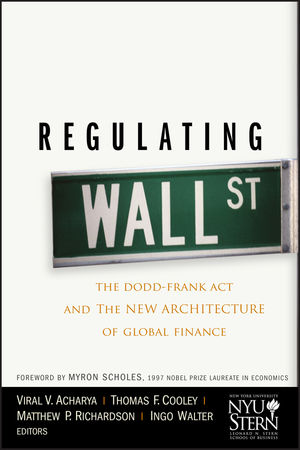Regulating Wall Street: The Dodd-Frank Act and the New Architecture of Global FinanceISBN: 978-0-470-76877-8
Hardcover
592 pages
November 2010
 This is a Print-on-Demand title. It will be printed specifically to fill your order. Please allow an additional 10-15 days delivery time. The book is not returnable.
|
||||||
Connect with Wiley Publicity
In December 2008, a working group of faculty from NYU Stern School of Business developed 18 independent policy papers on the causes of the financial crisis and proposals for market-based solutions, which captured the attention of policymakers in Washington and were published in a book, Restoring Financial Stability (Wiley, March 2009). In reaction to the passage of the Dodd-Frank Act, the most significant U.S. financial regulation since the 1930s, they return with a strong call-to-action to regulators in their current book, REGULATING WALL STREET (Wiley; November 2010; $49.95; 978-0-470-76877-8).
More than 40 NYU Stern finance, economics, and accounting professors stress key flaws in the bill, and how these failures could set the next global financial crisis in motion. As 11 different regulatory agencies now begin the process of adopting the Act’s 243 new formal rules, the faculty offer key proposals to integrate into this critical legislation whose outcomes, due by December 2011, will shape the future of global financial architecture for years to come.
Major Criticisms of the Act
Flaw #1: Government guarantees remain mispriced in the financial system, leading to moral hazard.
- Problem: The Dodd-Frank Act needs to address the fact that financial institutions can still finance their activities at below-market rates, effectively a subsidy, and take on excessive risk. It is unlikely that the Act’s proposed orderly liquidation authority will be a sufficient remedy.
- Recommendation: Dodd-Frank should recognize and charge financial firms for these guarantees where they exist. Furthermore, the book describes more credible resolution plans to deal with failures of every type of institution, so that market discipline can be restored to financial markets.
Flaw #2: The Act does not sufficiently discourage individual firms from putting the system at risk.
- Problem: Firms need to be held accountable not just for their own losses, but also for the cost that their failure would impose on the system. While the Act tries to achieve this goal, it is poorly designed in that surviving banks pay the cost of the failed firms who contribute to systemic risk. If and when another crisis evolves, banks, already struggling for survival, should not have to bear the financial burden of failing institutions.
- Recommendation: The authors develop a new measure of systemic risk and then show how firms can optimally be made to internalize systemic risk costs whether through an upfront systemic risk tax, through higher capital requirements, or through some limits on systemically risky activities.
Flaw #3: The Act falls into the familiar trap of regulating by form rather than function.
- Problem: By solely addressing the failures of banking institutions, regulators are excluding the systemically important shadow banking system that serves similar functions, such as clearing houses or money market funds. Excluding these groups of institutions makes the system vulnerable, prohibits access to emergency funding, and creates an unlevel playing field.
- Recommendation: The book suggests that it is imperative the Act address the shadow banking system and its resulting systemic risk and treat many shadow institutions in the same way it treats banks. Doing so will better account for the prevalent systemic risk and limit the amount of shadow activity that is dangerous and unregulated.
Flaw #4: Regulatory arbitrage is not adequately addressed, so large parts of the shadow banking sector remain in their current form.
- Problem: The tale of this crisis was that large, complex financial institutions exploited capital regulatory requirements to take a concentrated one-sided bet, and other parts of the financial system managed to avoid requirements all together by operating in the “shadows.” Many of the problems can be sourced to the Basel Accords and its approach to regulation.
- Recommendation: The authors recommend and provide suggestions for a consistent framework so that financial innovation arises from efficiency considerations and not regulatory loopholes. Special attention is given to OTC derivatives, repo, and money markets.



